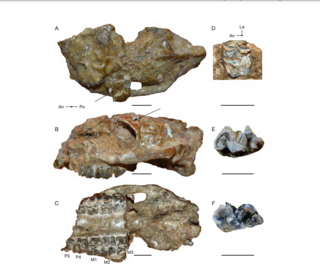
Sudamerica, literally "South America" in Spanish, is a genus of mammal from the extinct suborder Gondwanatheria that lived in Patagonia, Argentina and Antarctica from the Middle Paleocene (Peligran), just after the end of the "Age of Dinosaurs", to the Early Eocene (Casamayoran).

Yareta or llareta is a velvety, chartreuse cushion plant in the family Apiaceae which is native to South America. It grows in the Puna grasslands of the Andes in Peru, Bolivia, northern Chile and western Argentina at altitudes between 3,200 and 5,250 metres.

Azorella is a genus of flowering plants in the family Apiaceae, native to South America, New Zealand, southeastern Australia, and the islands of the Southern Ocean.
Campylodoniscus is a genus of titanosaur sauropod dinosaur from the Late Cretaceous Period of what is now Argentina.

Halophytum ameghinoi is a species of herbaceous plant endemic to Patagonia. It is the only species in the genus Halophytum. It is a succulent annual plant, with simple, fleshy, alternate leaves. The plants are monoecious, with solitary female flowers and inflorescences of male flowers on the same plant .

Azorella selago is a species of cushion plant native to the sub-Antarctic islands of the Southern Ocean, including the Crozet Islands, the Possession Islands, the Heard Island and McDonald Islands, the Kerguelen Islands, and the Prince Edward Islands. The closely related Azorella macquariensis, which is endemic to Macquarie Island, was split from it taxonomically in 1989. A. selago is often a keystone species where it occurs and is well studied for its contribution to its native ecosystems.
Azorella diapensioides is a species of flowering plant in the genus Azorella found in Peru and Bolivia.
Azorella filamentosa is a species of flowering plant in the genus Azorella existing in Chile and the Falkland Islands.
Azorella fuegiana is a species of flowering plant in the genus Azorella found in Chile.

Azorella macquariensis, also known as Macquarie azorella or Macquarie cushions, is a species of cushion plant endemic to Australia’s subantarctic Macquarie Island. It was referred to the more widely distributed Azorella selago until 1989, when it was described as a separate species.

Azorella polaris, commonly known as the Macquarie Island cabbage, is a species of flowering plant usually placed in the family Araliaceae and only very distantly related to cabbage. It is a megaherb, growing up to about a metre in height, native to the subantarctic islands of New Zealand and to Australia’s Macquarie Island.
A. pedunculata may refer to:

Tasmanian cushion plants are low growing, highly compact, woody, spreading mats that can grow up to 3 m in diameter, located mainly on the island of Tasmania. These mats are made up of tightly packed stems that grow at the same rate so that no apical rosettes protrude above the rest. The term cushion plant refers to a characteristic growth habit adopted by various species from a range of families to adapt to alpine and subalpine environments and areas of high latitude. They are adapted to grow in low nutrient areas and typically have deep taproots. Cushion plants are very slow growing and do not grow high above ground; mounds typically remain under 30 cm high. Underneath the living surface of the cushion, the plants either allow dead leaves to persist or produce non-photosynthetic material, resulting in an insulating effect.

Benthamiella is a genus of plants in the family Solanaceae, native to Patagonia in southern South America. Its species have been described as "attractive, small, cushion plants".
Azorella albovaginata is a species of flowering plant in the genus Azorella found in northwest and south Argentina. Azorella albovaginata var. pauciflorum is a variety of the species and is found in central Chile
Azorella aretioides is a species of flowering plant in the genus Azorella found in Colombia and Ecuador. Azorella aretioides var. elongata is a variety of the species, also found in Colombia and Ecuador.
Azorella atacamensis is a species of flowering plant in the genus Azorella found in Argentina and Chile.

Azorella schizeilema is a species of cushion plant in the Apiaceae family, native to the Auckland and Campbell Islands.

Neobrachytherium is an extinct genus of proterotheriid mammal from the Late Miocene of Argentina and Uruguay. It is represented by multiple species, including the type N. intermedium, originally named in 1891 by Moreno and Mercerat as a species of Licaphrium, N. morenoi, originally named in 1914 by Rovereto as a species of Brachytherium, and N. ameghinoi and N. ullumense, named in 2001 by Soria, who reclassified all the species in the new genus Neobrachytherium. The various species are known from cranial and dental material from the Corral Quemado, Loma de las Tapias and Ituzaingó Formations. Neobrachytherium may be closely related to Thoatherium, Diadiaphorus and Thoatheriopsis.
Azorella monteroi is a species of flowering plant in the family Apiaceae. It is endemic to southern Chile in the Biobío and Araucanía regions.










